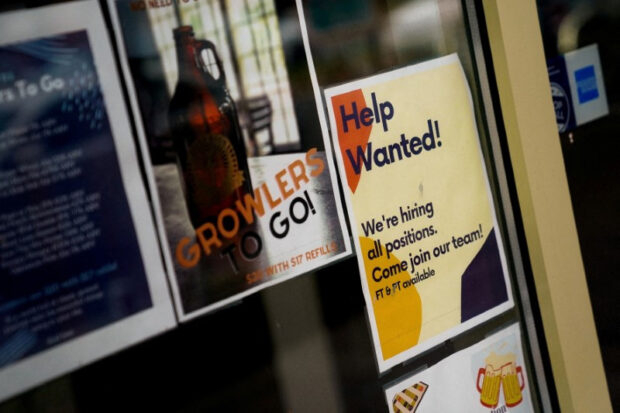US economy grew 5.2% in Q3; higher interest rates sapping momentum

An employee hiring sign is seen in a window of a business in Arlington, Virginia, U.S., April 7, 2023. REUTERS/Elizabeth Frantz/File photo
WASHINGTON – The U.S. economy grew faster than initially thought in the third quarter as businesses built more warehouses and accumulated machinery equipment, but momentum appears to have since waned as higher borrowing costs curb hiring and spending.
The growth pace, which was the quickest in nearly two years, however, likely exaggerated the health of the economy last quarter. When measured from the income side, economic activity increased at a moderate pace.
Nevertheless, the mixed report from the Commerce Department on Wednesday was another reminder that the economy continued to grow despite fears of a recession that have persisted since late 2022.
“No sign of darkening skies for the economy in today’s report, but growth is cooling,” said Christopher Rupkey, chief economist at FWDBONDS in New York. “There’s simply not as much wind in the economy‘s sails in the final quarter this year.”
Gross domestic product increased at a 5.2 percent annualized rate last quarter, revised up from the previously reported 4.9 percent pace, the Commerce Department’s Bureau of Economic Analysis (BEA) said in its second estimate of third-quarter GDP. It was the fastest pace of expansion since the fourth quarter of 2021.
Economists polled by Reuters had expected GDP growth would be revised up to a 5-percent rate. The economy grew at a 2.1- percent pace in the April-June quarter and is expanding at a pace well above what Federal Reserve officials regard as the non-inflationary growth rate of around 1.8 percent.
The upward revision to growth last quarter reflected upgrades to business investment on structures, mostly warehouses and healthcare facilities. Spending by state and local governments was also revised higher.
READ: Fed policymakers see rates staying high for ‘some time’
Residential investment was also raised, thanks to the construction of more single-family homes, helping to end nine straight quarters of contraction.
Private inventory investment was higher than previously estimated as wholesalers amassed more machinery equipment. Inventory investment added 1.40 percentage points to GDP growth, instead of the 1.32 percentage points estimated last month.
But growth in consumer spending, which accounts for more than two-thirds of U.S. economic activity, was lowered to a still-solid 3.6 percent rate. The downgrade from the previously estimated 4 percent growth pace was because of cuts to outlays on financial services and insurance as well as used light trucks, likely the result of shortages caused by the recently ended United Auto Workers strike.
Stocks on Wall Street were trading higher. The dollar edged up against a basket of currencies. U.S. Treasury prices rose.
Mixed details
After-tax profits without inventory valuation and capital consumption adjustment, which corresponds to S&P 500 profits, increased by $126.2 billion, or at a 4.3-percent rate. Profits rose at a 0.8- percent rate in the second quarter. The increase in profits occurred across domestic financial and non-financial corporations as well as from the rest of the world.
Personal income was higher than initially estimated, accounting for increases in wages. The saving rate was raised to 4 percent from 3.8 percent. Higher wages contributed to the economy growing at a 1.5- percent rate last quarter, the fastest in a year, when measured from the income side.
Gross domestic income (GDI) increased at a rate of 0.5 percent in the second quarter. But GDI contracted at a 0.2 percent pace on a year-on-year basis, the first decline in three years.
“The only time the economy measured by incomes has declined at this pace and was not in recession was in the third quarter of 2007. A recession began in the next quarter,” said Conrad DeQuadros, senior economic advisor at Brean Capital in New York.
In principle, GDP and GDI should be equal, but in practice differ as they are estimated using different and largely independent source data. The gap between GDI and GDP has re-widened after narrowing when the BEA implemented its annual benchmark revisions in September.
“While the recent performance of the economy looks much less impressive on the GDI numbers, both series ultimately suggest that the economy has avoided recession this year,” said Michael Pearce, lead U.S. economist at Oxford Economics in New York.
The average of GDP and GDI, also referred to as gross domestic output and considered a better measure of economic activity, increased at a 3.3- percent rate in the July-September period, quickening from a 1.3- percent growth pace in the second quarter.
That, however, is in the past as economic activity looks to have cooled significantly at the start of the fourth quarter, with retail sales falling for the first time in seven months in October. Job growth slowed last month and the unemployment rate rose to a nearly two-year high of 3.9 percent.
Moderate growth prospects were reinforced by other data from the Census Bureau showing the goods trade deficit widening 3.4 percent to $89.8 billion in October as exports declined. That suggested trade could be a drag on GDP growth this quarter after being a neutral factor in the April-June period. Wholesale inventories dropped, while stocks at retailers were unchanged.
Slowing demand has raised optimism that the Fed is probably done raising interest rates this cycle, with financial markets even anticipating a rate cut in mid-2024. Since March 2022, the U.S. central bank has raised its benchmark overnight interest rate by 525 basis points to the current 5.25 percent-5.5 percent range.
The GDP report also confirmed inflation was trending lower, with slight downward revisions to measures watched by the Fed for monetary policy.
“The Fed could find themselves in a sweet spot,” said Jeffrey Roach, chief economist at LPL Financial in Charlotte, North Carolina. “Inflation is trending lower, the consumer is still spending, but at a slower pace. The Fed could end its rate-hiking campaign without much pain inflicted on the economy.”